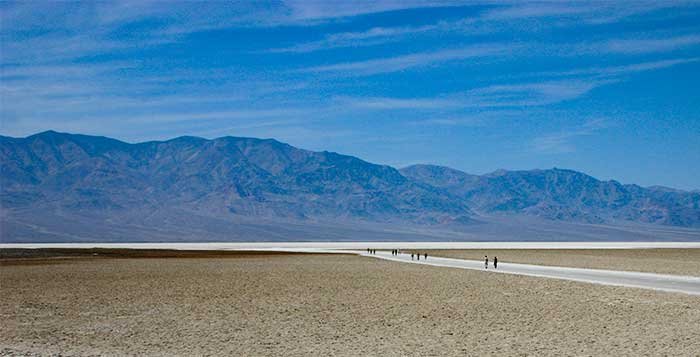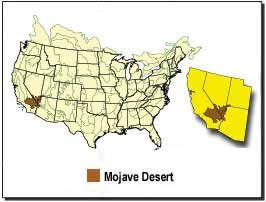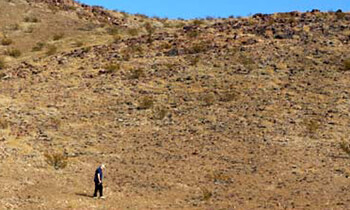Mojave Desert
Location | Mojave Desert Map |
Mojave National
Preserve | Weather | Plants and Animals
Where is the Mojave Desert?
A majority of the Mojave Desert is located in southeastern California and southern Nevada, with smaller portions in Utah and Arizona. The Mojave Desert occupies approximately 43,750 square miles and is considered the smallest and driest desert in the United States.
The Mojave Desert is situated in a transitional zone between the Great Basin Desert to the north and the Sonoran Desert to the south (mainly between 34 and 38°N latitudes).
The Mojave Desert, a rain-shadow desert, is defined by a combination of latitude, elevation, geology, and indicator plants.

Badwater Death Valley 282 feet Below Sea Level
What is the Mojave Desert famous for?
The Mojave Desert is famous for having the hottest air temperature and surface temperature recorded on earth and the lowest elevation in North America.
Furnace Creek, located in Death Valley, recorded 134 F (56.7 C) on July 10th, 1913. On July 15th, 1972, the surface temperature in Furnace Creek was recorded at 201 F (93.9 C).
Badwater Basin, located in Death Valley, is the lowest elevation in the United States. At its lowest point, Badwater Basin measures 279 feet (85 m) below sea level.
Dust Devil in the Mojave Desert
Plan Your Mojave Desert Adventure
Whether you’re planning a weekend getaway or an off-road expedition, the Mojave Desert offers unique experiences year-round. Key tips for a successful visit:
-
Best time to visit: October to April for cooler temperatures and blooming wildflowers.
-
Stay safe: Carry extra water, let someone know your travel plans, and avoid remote travel in the heat of summer.
-
Camping: Dispersed camping is allowed on BLM and Preserve land—just follow Leave No Trace guidelines.
-
Activities: Hiking, photography, rockhounding, ghost town exploring, and stargazing under some of the darkest skies in the U.S.
Geography of the Mojave Desert
The Mojave Desert has a typical mountain-and-basin topography with sparse vegetation. Sand and gravel basins drain into central salt flats from which borax, potash and salt are extracted. Silver, tungsten, gold and iron deposits are also present in the Mojave Desert.
Elevations are generally between three and six thousand feet, although Death Valley National Park includes both 11,049-foot Telescope Peak and the lowest point in the United States, 282 feet below sea level, at Badwater Basin.
Weather in the Mojave Desert
Temperatures are a function of both latitude and altitude. Although the Mojave Desert has the lowest absolute elevation and the highest maximum temperature (134°F in Death Valley), it is north of the Sonoran Desert and its average elevations are higher. As a result, its average temperatures are lower than those of the Sonoran Desert.
Did You Know? The Mojave Desert supports over 2,000 species of plants and animals—many of which are endemic and under threat from climate change and development.
Plants in the Mojave Desert
Occasional catclaws grow along arroyos. But, unlike the Sonoran Desert, trees are few, both in numbers and diversity in the Mojave Desert. The exception is the Joshua tree. While this unusual tree-like yucca is usually considered the prime indicator of Mojave Desert vegetation, it occurs only at higher elevations in this desert and only in this desert.

The Mojave Desert hosts about 200 endemic plant species found in neither of the adjacent deserts. Cactus are usually restricted to the coarse soils of bajadas. Mojave yucca and, at higher elevations desert Spanish bayonet, a narrow-leafed yucca, are prominent. Creosote bush, shadscale, big sagebrush, bladder-sage, bursages and blackbush are common shrubs of the Mojave Desert. See Wildflower Bloom Reports
Animals in the Mojave Desert
Animals have adapted to survive extreme heat and dryness—desert tortoises burrow underground, kangaroo rats live without ever drinking water, and sidewinder rattlesnakes slither across the sand with a unique sidewinding motion.
A few examples of desert animals that live in the Mojave Desert include: bats, bighorn sheep, coyotes, black-tailed jack rabbits, foxes, rattlesnakes, and chukwallas.

Explore the Wild Beauty of the Mojave
The Mojave Desert is home to some of the most spectacular and remote protected lands in the United States. These include:
-
Mojave National Preserve – over 1.6 million acres of lava flows, sand dunes, and historic trails.
-
Joshua Tree National Park – world-famous for rock climbing, surreal landscapes, and twisted Joshua trees.
-
Death Valley National Park – the hottest, driest, and lowest place in North America.
-
Lake Mead National Recreation Area (NRA)– offering boating and scenic views along the Colorado River.
Other highlights include Amboy Crater, Kelso Dunes, and historic ghost towns like Calico and Rhyolite.

National Park Service Map
Points of Interest in the Mojave Desert
Mojave Road
The Mojave Road crosses the Mojave Preserve and was a main wagon trail for only a relatively short time, two decades after the civil war. When the railroads came, the railways created an easier route to the south complete with oases on the bitter-dry deserts. While it was used, the Mojave Road was a route plagued by hostile Indians, a lack of water, long stretches of sand and rough hill climbs. For caravans of travelers and a handful of soldiers, it was a proving ground that brought out the best and the worst of them. Read more about the Mojave Road.
Balancing Access and Preservation
The Mojave Desert is at the center of ongoing environmental challenges. Recent wildfires—such as the 2020 Dome Fire—have destroyed thousands of acres of Joshua tree woodland. At the same time, development pressures and controversial water projects, like the proposed Mojave Groundwater Bank, pose new threats to fragile desert ecosystems.
Conservation efforts led by the Mojave Desert Land Trust and the National Park Service are helping restore habitats, protect endangered species, and educate the public about the value of this unique region.
🌱 How You Can Help: Stay on marked trails, pack out all waste, and support restoration initiatives.
You
might also be interested in:
Motor Home Exploration in the Mojave
Share this page on Facebook:
The Desert Environment
The North American Deserts
Desert Geological Terms










